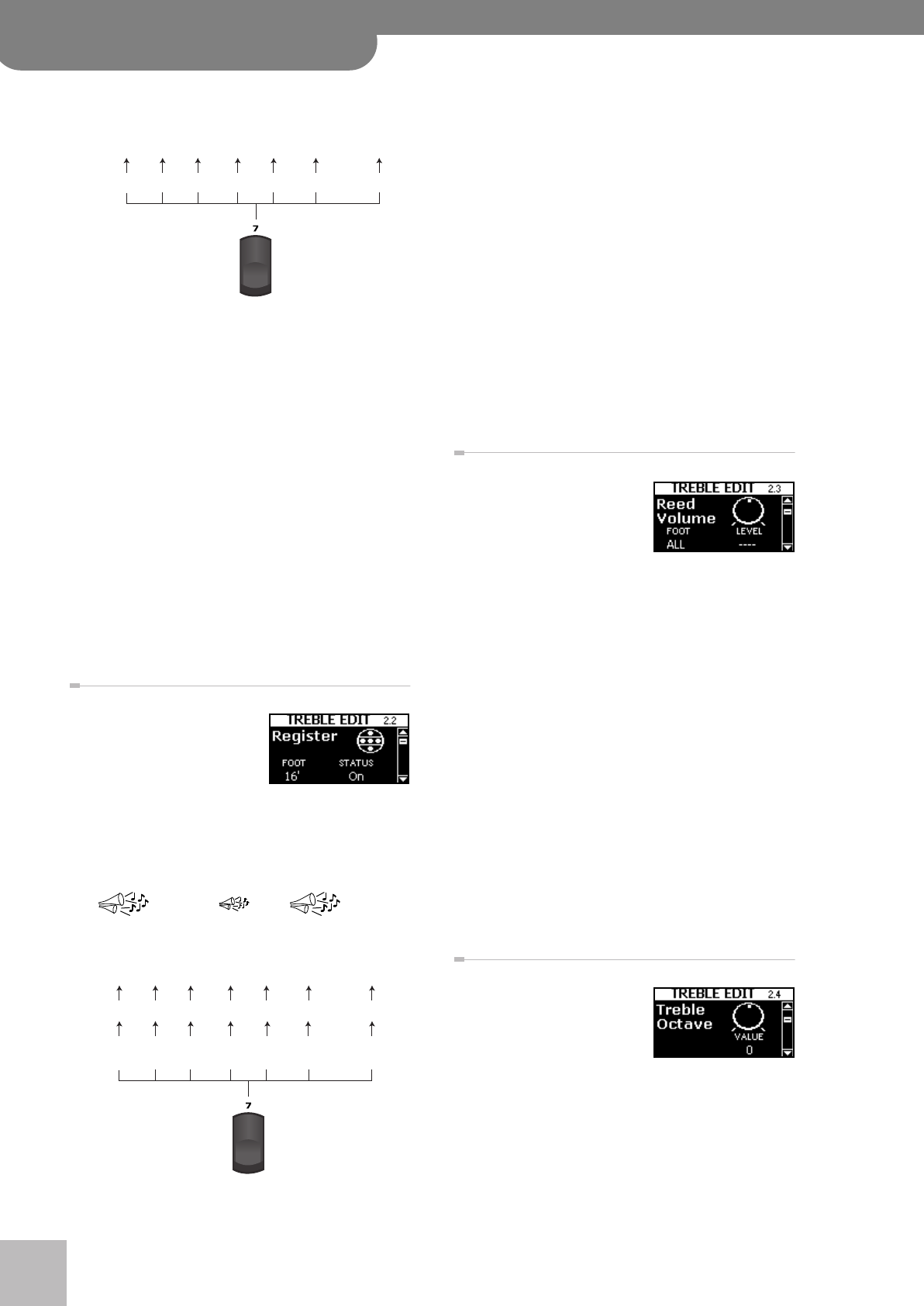
®
2. Treble Edit parameters (Advanced)
66
r
FR-7x V-Accordion
(1) Press the [DATA÷ENTER] knob to select the “FOOT”
parameter, then rotate the [DATA÷ENTER] knob to
select the reed you wish to assign another sound
to.
The options are: ALL, 16’, 8’, 8’–, 8’+, 4’, 5-1/3’, 2-2/3’
(2) Press the [DATA÷ENTER] knob to select the “TYPE”
parameter, then rotate the [DATA÷ENTER] knob to
select a type (“instrument”).
The TYPE options are: Bandoneon, I-Folk, I-Folk2,
Classic, Cajun, Jazz, F-Folk, D-Folk, Organetto, F-Folk2,
Classic2, Studio, Tradition, Steierische, OldItaly,
TexMex, Trikitixa, F-Jazz, Classic3, Bajan.
Note: Whenever you select “ALL” and set a different reed
type, the “Valve Noise” setting (page 67) is automatically
adapted to the reed type you select here. You may have to
change it afterwards if you wish to use a different noise
type.
2.2 Register
The parameters on this page
are used in combination with
the settings above. Here, you
decide which feet should be
audible and how they should
be played. It is therefore on this page that you specify
whether the sounds you selected above will indeed be
used.
Let us first look at an illustration:
In our example, only 16’, 8’+ and 5-1/3’ are used. 8’+ is
slightly softer than then other two reeds, because the
Cassotto function is on. “Cassotto” is similar to the “Sor-
dina” function discussed on page 25, but it only muffles
the reed/footage in question (making the sound darker).
The SORDINA switch, on the other hand, applies to all
accordion sounds of the Treble section.
(1) Press the [DATA÷ENTER] knob to select the “FOOT”
parameter, then rotate the [DATA÷ENTER] knob to
select the reed you wish to assign another sound
to.
The options are: 16’, 8’, 8’–, 8’+, 4’, 5-1/3’, 2-2/3’
(2) Press the [DATA÷ENTER] knob to select the “STA-
TUS” parameter, then rotate the [DATA÷ENTER]
knob to specify whether the selected reed should
sound and whether it should be muffled.
The STATUS options are: Off (no sound), On (sounds),
On-Cassotto (muffled sound).
2.3 Reed Volume
This is the last parameter that
can be set for each reed/foot-
age individually. It allows you
to create the desired “mix”
(volume balance) for the
active reeds (see the “2.2 Register” page).
This is a relative parameter: its value is added to or sub-
tracted from the standard value (“Std”). As a rule, first
decide which reed is most important and set its “Vol-
ume” parameter to “Std”. Then reduce or increase the
volume of the “ancillary” reeds to create the desired bal-
ance.
(1) Press the [DATA÷ENTER] knob to select the “FOOT”
parameter, then rotate the [DATA÷ENTER] knob to
select the reed whose volume you want to set.
The options are: ALL (all reeds simultaneously), 16’, 8’,
8’–, 8’+, 4’, 5-1/3’, 2-2/3’
(2) Press the [DATA÷ENTER] knob to select the “LEVEL”
parameter, then rotate the [DATA÷ENTER] knob to
set the volume.
The setting range is: Off, –40~“Std”~40, Default set-
ting: Std
Note: The overall volume of the Treble section (all regis-
ters) can be changed using the [BALANCE] knob.
2.4 Treble Octave
(–1, 0, +1, Default setting: 0)
This parameter allows you to
transpose the selected register
one octave up (“+1”) or down
(“–1”).
This can be used for two purposes:
•to quickly correct the pitch that results from the
active reeds (see above) –or–
•to avoid overlaps of the selected register when using
an ORCHESTRA sound. (The ORCHESTRA section also
provides an “Octave” parameter.)
<16> <8> <8–> <8+> <4> <5-1/3> <2-2/3>
Bandoneon
Classic
Cajun
F-Folk
Steierische
TexMex
Triktixa
<16> <8> <8–> <8+> <4> <5-1/3> <2-2/3>
Bandoneon
Classic
Cajun
F-Folk
Steierische
TexMex
Triktixa
On Off Off
On-
Cassotto
Off On Off
FR-7x GB.book Page 66 Tuesday, August 25, 2009 10:58 AM


















